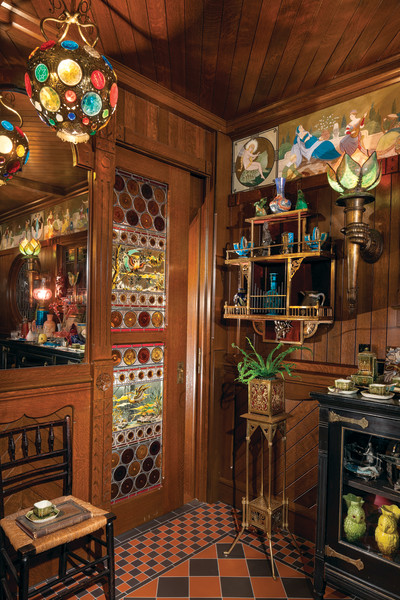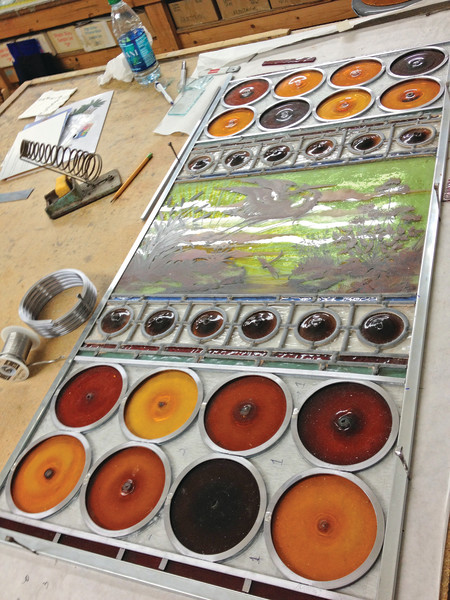
Restored stained glass.
The homeowner is dedicated to reusing artful salvage and, in fact, had amassed a tidy collection of building elements, including stained-glass panels, which he had stored away. Having added a conservatory to the back of his turn-of-the-century Victorian cottage, he wanted to close off the new room from the original front entry hall and back stairs, but a traditional swinging door would cause wasted space. Aha—a sliding pocket door would do the trick—one door to the entryway and the other to the stairs. He thought of his salvaged treasures: a glowing cranberry-glass pane with an etched stork motif, and another set of Aesthetic Movement panels painted with period motifs including an owl and moon. So he did what a 19th-century homeowner might have done, creating two pocket doors inset with art glass, which would provide filtered light and privacy when closed, and disappear into pockets when open.
Admittedly, fitting a door with stained glass and creating a new wall pocket with sliding hardware is not a weekend makeover. It’s an exacting project even if the pockets are already there and you are merely fitting solid doors with glass panels. Most people would not consider this a DIY job.
Any solid, paneled door can be made into a pocket door, its panels removed by a competent woodworker and replaced with glass. (You may, of course, find a vintage door already fitted with etched, leaded, or stained glass.) The glass panel itself must be in excellent shape or well restored. Copper foil applied with lead solder is usually the best method for restoring antique art glass. Or consider using “Restrip,” a newer, internal strengthening product of very thin, flexible, copper-coated steel bands that can be placed between the joints and against the came channels instead of rebar for invisible support. For additional insurance, a thin gasket of closed-cell tape may be applied along the rabbet as a cushion, enabling the glass to float without pressure points and better absorb the door’s sliding movements. If you need to rework the design for the glass—say, combining new glass with old—an online design program can make life much easier. Try Glass Eye 2000: dfly.com

There are two components of pocket-door hardware, decorative and functional: pulls and locksets, and the operating rollers and track.
To prepare the wall, choose an area with minimal plumbing and wiring, as it’s expensive to relocate those. The pocket is framed with split studs in wood or metal; the door’s weight will determine the size of header needed. Online kits make the process fairly straightforward, explaining how to install rollers and tracks. Pocket Door Products has a good selection.
SMART TIPS

Stained glass restoration.
If there is wiring or plumbing in the wall and you don’t want to relocate it, the pocket door can be offset by framing out the wall the thickness of the door, and camouflaging it with trim.
If the tracks are aluminum and shiny, have them powder-coated a bronze or dark brown color by a metal refinisher.
A rubber bumper at the back of the track will prevent the door from banging when it slides open into the pocket.
THE HARDWARE
There are two components of pocket-door hardware, decorative and functional: pulls and locksets, and the operating rollers and track.
Operating Hardware
The door rides through a hollow, U-shaped aluminum channel hung from the header, and is suspended by a pair of metal trucks screwed into each end of the door’s top, which slide it along the channel on four ball-bearing wheels. A plastic guide on the bottom of the door helps keep it centered. This operating hardware is available in kits at most hardware stores, but don’t skimp: Be sure to buy a good set to avoid malfunctions. Stanley and Baldwin are always reliable.
Decorative Hardware
Flush pocket-door pull escutcheons come a wide variety of historical styles, and may be combined with passage sets with edge pulls. (This comes in handy when the door gets pushed back into the wall pocket, and you need a point of leverage to pull it out.) eBay usually has a good selection of vintage pocket-door hardware to choose from.







